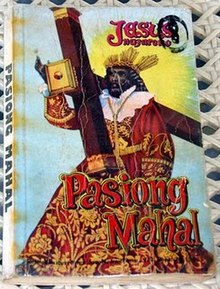Pasyon

Cover of a typical edition of the Pasyóng Mahál, featuring a depiction of the Black Nazarene of Quiapo.
|
|
| Author | Rev. Fr. Mariano Pilapil |
|---|---|
| Original title | Pasióng Mahal |
| Translator | filipino |
| Country | Philippines |
| Language | Tagalog, other Philippine languages |
| Genre | epic poetry, narration, religious, prayer |
|
Publication date
|
1704 (de Belén Edition) |
| Media type | |
| Pages | ± 240 |
The Pasyón (Spanish: Pasión) is a Philippine epic narrative of the life of Jesus Christ, focused on his Passion, Death, and Resurrection. In stanzas of five lines of eight syllables each, the standard elements of epic poetry are interwoven with a colourful, dramatic theme.
The uninterrupted recitation or Pabasa of the whole epic is a popular Filipino Catholic devotion during the Lenten season, and particularly during Holy Week.
The text is an adaptation of the pre-Hispanic Filipino art of chanting epic poems as a part of oral tradition. After Christianity was introduced by the Spanish, the Passion cycle was adapted into this native narrative form.
The indigenous form of the Pasyón was first written down by Gaspar Aquino de Belén in "Ang Mahal na Pasión ni Jesu Christong Panginoon Natin na Tola" ("The Sacred Passion of Jesus Christ Our Lord that is a Poem"), written in 1703 and approved in 1704.
An 1852 erudition by Aniceto de Merced, El libro de la vida ("The Book of the Life [of Jesus]") did not prove popular with the masses.
The most popular Tagalog version of the Pasyón is the "Casaysayan nang Pasiong Mahal ni Jesucristong Panginoon Natin na Sucat Ipag-alab nang Puso nang Sinomang Babasa" ("The History of the Passion of Jesus Christ Our Lord, which Surely Shall Ignite the Heart of Whosoever Readeth").
...
Wikipedia
